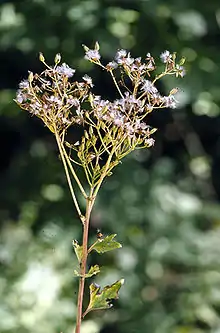Arnoglossum atriplicifolium
Arnoglossum atriplicifolium, the pale Indian plantain, is a perennial herbaceous wildflower in the sunflower family (Asteraceae).[2] native to the central and eastern United States. It can reach heights of up to 3 metres (10 ft), with dramatic clusters of white flowers at the top of a central, unbranching stalk.
| Arnoglossum atriplicifolium | |
|---|---|
 | |
| Scientific classification | |
| Kingdom: | Plantae |
| Clade: | Tracheophytes |
| Clade: | Angiosperms |
| Clade: | Eudicots |
| Clade: | Asterids |
| Order: | Asterales |
| Family: | Asteraceae |
| Genus: | Arnoglossum |
| Species: | A. atriplicifolium |
| Binomial name | |
| Arnoglossum atriplicifolium (L.) H.Rob. | |
| Synonyms[1] | |
|
Synonymy
| |
Description
Arnoglossum atriplicifolium is a large perennial plant with an unbranched stalk up to 2 metres (5 ft) tall, sometimes much taller, rising from a basal rosette up to 0.3 metres (1 ft) wide. The stalk is pale green to pale purple and has alternate leaves measuring up to 20 centimetres (8 in) long and 20 centimetres (8 in) across, becoming smaller as they ascend the stalk.[3] The stems and lower surface of the leaves have a grayish white color, which is the source of the "pale" in the common name and is a distinguishing feature when differentiating it from other species in the Arnoglossum genus.[4]
At the top of the central stalk is a flat-topped corymb, or cluster, of 4 to 15 flower heads.[3][5] Flower heads are white, sometimes with a bit of green or purple, with disc florets but no ray florets.[3] The plant spreads by means of underground rhizomes.

Distribution and habitat
It is widely distributed through the central and eastern states of the United States from the Atlantic Coast westward as far as Kansas,[6] but it is listed as endangered in the state of New Jersey. It grows in pastures, roadsides, and edges of woods.[2]
Ecology
Flowers bloom July to November.[7] The plant is pollinated by insects, primarily wasps, including sand wasps (Bicyrtes), great black wasps (Sphex pensylvanicus), great golden digger wasps (Sphex ichneumoneus), and thread-waisted wasps, ( Ammophila spp.)[8] flies, and small bees.[3]
References
- The Plant List Arnoglossum atriplicifolium (L.) H.Rob.
- Flora of North America Vol. 20 Page 623 Arnoglossum atriplicifolium (Linnaeus) H. Robinson
- "Pale Indian Plantain (Arnoglossum atriplicifolium)". www.illinoiswildflowers.info.
- "Arnoglossum atriplicifolium - Plant Finder". www.missouribotanicalgarden.org.
- Denison, Edgar (2017). Missouri Wildflowers (Sixth ed.). Conservation Commission of the State of Missouri. p. 48. ISBN 978-1-887247-59-7.
- Biota of North America Program 2014 county distribution map
- "Lady Bird Johnson Wildflower Center - The University of Texas at Austin". www.wildflower.org.
- "Weird and Wonderful Plants for Pollinators: Pale Indian Plantain". Xerces Society.
External links
- Illinois Wildflowers
- Lady Bird Johnson Wildflower Center, University of Texas
- Plants of the Eloise Butler Wildflower Garden Archived 2015-05-24 at the Wayback Machine
- Delaware wildflowers
- Michigan flora
- Digital Atlas of Virginia Flora
 Media related to Arnoglossum atriplicifolium at Wikimedia Commons
Media related to Arnoglossum atriplicifolium at Wikimedia Commons Data related to Arnoglossum atriplicifolium at Wikispecies
Data related to Arnoglossum atriplicifolium at Wikispecies